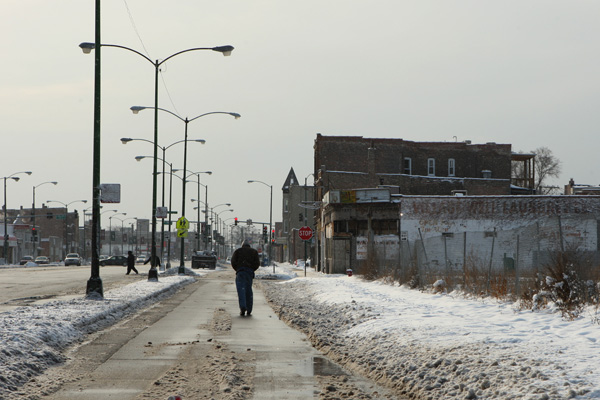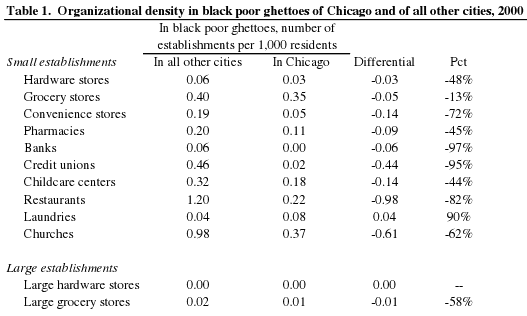
Photo: Nancy Stone / Chicago Tribune
Ogden Avenue in Lawndale
Bloomberg Businessweek has a good piece today on the economic costs of crime in Chicago, starting with Jens Ludwig's oft-cited calculation that gun violence costs the city $2.5 billion a year. From there, reporters Tim Jones and John McCormick look at how those costs add up: hundreds of thousands of dollars in trauma care for a single shooting (costs that often fall to the county at an average of $52k for each case of trauma care at Stroger Hospital); thousands of dollars in salary for the cops investigating the crime; lost wages from the critically injured; and on, and on.
Since it's a business magazine, they also focus on the economic costs to the city's retail base:
Violence has prompted the South Shore chamber of commerce to discourage businesses from staying open at night and to seek fines—and even shutter—stores that tolerate loitering. Merchants struggle with people selling individual cigarettes called “loosies” and illegal drugs.
Two months after Glinsey was fatally shot outside Budget Food & Liquors, the tax preparer next door fled. The Jackson Hewitt branch moved eight blocks north to 71st Street, near a shopping center anchored by franchise drug, electronics, grocery and sandwich outlets.
That wasn’t far enough. On the evening of April 30, three men were shot near the stores. The next morning, a 27-year-old man was killed about three blocks away.
Wertz, the executive director of the South Shore Chamber Inc., has a different challenge than her peers in most suburbs or more stable city neighborhoods.
The South Shore commercial strips she touts are defined mostly by beauty salons, wig shops, liquor stores, check cashing operations and tax preparation outlets. Wertz’s wish list: auto parts, shoes, a pancake house, a Marshalls and a T.J. Maxx.
There's not much data behind that part of the piece. So I wish this had made it in. It doesn't look very shocking at a glance, but it is.

Translated: that means Chicago's poorest neighborhoods are tremendously business-poor, even compared to other cities' poorest neighborhoods. As the author, Marco Luis Small, puts it: "In some cases, the difference is stark. Chicago has 82% fewer small restaurants, 95% fewer small banks, and 72% fewer small convenience stores than a black poor ghetto in the average city…. The average black poor neighborhood in the U.S. does not look at all like the South Side of Chicago."
The effects go beyond mere economic loss. In Heat Wave, Eric Klinenberg notes the differences between North and South Lawndale and their effects on the death rate during the 1995 heat wave:
"In North Lawndale, the dangerous ecology of abandoned buildings, open spaces, commercial depletion, violent crime, degraded infrastructure, low population density, and family dispersion undermines the viability of public life and the strength of local support systems," he writes. "In Little Village, though, the busy streets, heavy commercial activity, residential concentration, and relatively low crime promote social contact, collective life, and public engagement in general and provide particular benefits for the elderly, who are more likely to leave home when they are drawn out by nearby amenities."
The same weather was ten times more dangerous in North Lawndale than it was in Little Village. In Little Village 3 people died, for a death rate of 4 per 100,000. In North Lawndale 19 people died, for a death rate of 40 per 100,000.
What struck Small when he moved to Chicago was this absence of activity—compared to, say, Harlem, which is poor but tremendously vibrant: "What I first noticed, and what took me months to get used to, was the utter lack of density, the surprising preponderance of empty spaces, vacant lots, and desolate streets, even as late as 2006. Repeatedly, I asked myself, where is everyone?"
Small doesn't know where. I don't think anyone knows for sure. But one theory tends to run through the city's recent history (and histories), as you read in Boss, American Pharaoh, and Larry Bennett's Third City. For the better part of the past 60 years, the people that ran the city—i.e. mostly the Daleys—threw their attention and the city's money towards the Loop. And as Edward McClelland writes in "Why the Smartest People in the Midwest All Move to Chicago," it worked. Central Chicago is thriving. And attention remains there, with news of the massive McPier renovations following on the heels of the city's forthcoming riverwalk.
But it doesn't actually end there. The most audacious city planning going on in Chicago—its most audacious city planning since the Great Fire—is centered way down south on the old U.S. Steel South Works site. "When built out over 30 years, Chicago Lakeside will be the site of 13,575 homes and 17.5 million square feet of stores and offices," McClelland writes. "The North Slip will become a sailboat marina; the rocky verge of the peninsula, a bathing beach." It will be a new Loop, on the ashes of the mills that built the old Loop.


